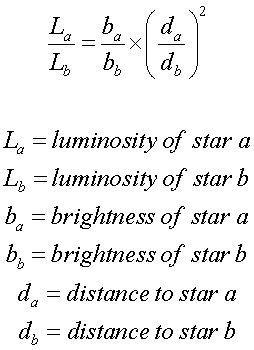| There are certain concepts that are
important to understand when dealing with the
physics of astronomy. In 1862, William Huggins was
the first astronomer to use
spectroscopy to study
the chemical composition are
stars and nebulas. This
was the birth of the field of science called
astrophysics.
We
already discussed the celestial
coordinate system,
so we will now focus on more fundamental physical
processes.
Of all of the physical concepts,
nothing is more important to astronomy than
proportions. Much of what we know of the other
planets and other
stars (and
galaxies for that
matter) is comparing them to what we know:
Earth,
Sun and
Milky Way galaxy.
For example, the
brightness of a
star is
proportional to its
brightness and
distance:

We can use this tool to help compare
brightness of
any
star to another, however to be
practical it is
best to compare to a know object - like our
Sun.
When comparing two
stars, this is the form the
proportionality will take:

Back to Top |

